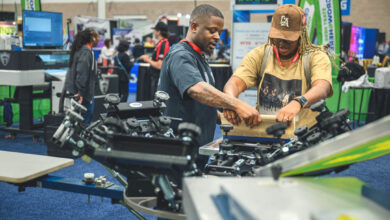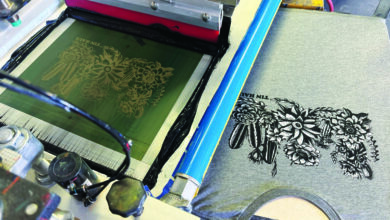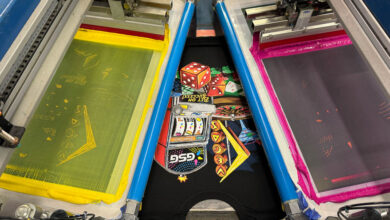
If you have ever tried printing on nylon, you understand the challenges. If you haven’t…oh boy, are you going to learn the hard way at some point. Poorly printed nylon results in either shrunken products out the back of the dryer or returned goods with the image scraping off. To prevent these problems, there are a few tips and tricks that can help.
The most commonly printed nylon materials I run into when visiting shops tend to be jackets, tote bags, and small banners. Each of these can have their unique set of variables, so it’s important to first understand the materials themselves. We know that nylon is a completely synthetic fiber known for its resilient flexibility, however, it has very limited heat resistance. Although there are many types of nylon, here are a few of the most common nylon fabrics found in a print shop.
Oxford Nylon: This is a heavy basket weave that usually requires a heavier deposit to cover the rough texture. You see this in tote bags and jackets.
Satin Nylon: A smooth finish achieved with an irregular weave. Often, shiny-looking jackets are made with this type of nylon.
Nylon goods can also be treated with a water-repellent coating. Gym bags and coach’s jackets often feature this coating. Some shops used to take rubbing alcohol and wipe the printable area with it to diminish the coating and allow for better bonding. That is still an option, however, I tend to recommend against it because it will more likely than not will leave a halo or a ghosted area. Instead, most ink manufacturers and garment vendors will recommend a nylon catalyst. The catalyst is the bonding agent that allows for the ink to stick to the nylon and the coating without easily peeling off. Discuss the measurements with your sales rep, but, usually, it’s mixed into your low-cure plastisol at around 1/16 parts by volume. Only mix up what you intend to use within a few hours, as the ink will harden once catalyzed. When it hardens, it tries to create a bond.
Printing Tips
There are some good points to printing on nylon. A single hit of white actually covers! When printing nylon, you want to avoid double hitting any color because it will increase the chance of ghosting or the edge of the print blowing out. Since you are not printing INTO the fabric like cotton, it is sitting on top of the surface and more likely to smear or lose its edge definition. Use the lowest mesh count your design will allow and focus on a single clear of the screen to have the best looking outcome. I would recommend either a hard single durometer or a hard triple durometer to make sure the screen clear is optimum.
Ink Selection: Most major ink manufacturers offer nylon base to mix with your inks. Some of them have properties already in their main lines that with just the addition of a nylon catalyst will work just fine. If you aren’t sure, check your ink manufacturer’s online resource guides or ask your local sales rep for help.
Curing: Achieving proper ink cure is often the hardest part of nylon printing because the goods are heat sensitive. Make sure your dryer has proper heat and no hot zones that could cause an extra heat spike in your chamber. Make sure to hold at least 300 degrees F when printing with catalyzed plastisol. Don’t forget, if printing a cinch bag or something along those lines, they often aren’t laundered, so make sure that the print holds up to a scratch test and a pull test after cured. If it holds up, more often than not, it’s plenty cured!
Carve out some time to get yourself a few different types of nylon goods and test! The best way to learn is to test and see results, especially when the results are negative. Knowing what not to do is often the best way to learn what to do. Good luck and happy printing!



